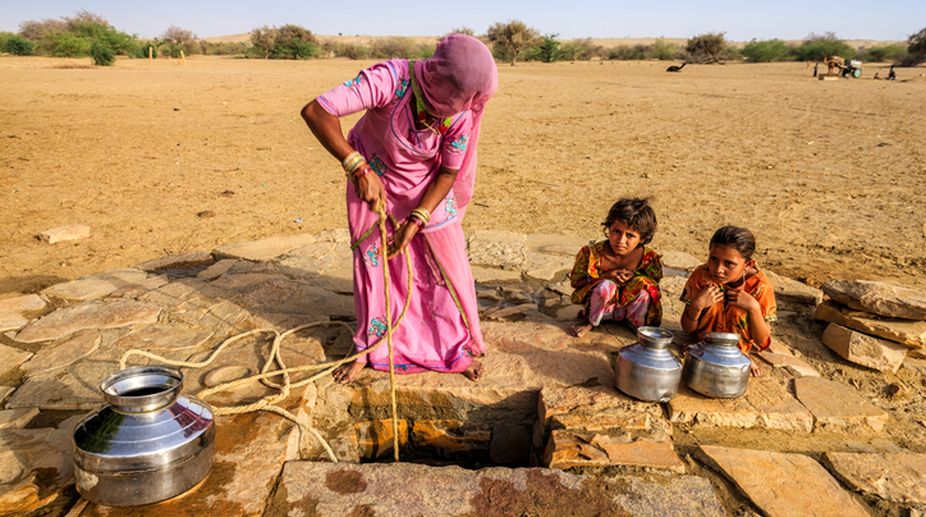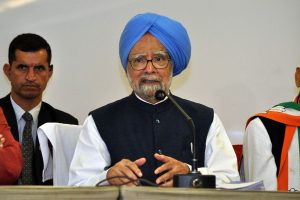Nothing has drilled deeper to the core of global policy meets over human developmental issues in recent times than the ramified adversities of climate change on lives and lands. Anomalous temperature bumps to drastic declines in precipitation, flash floods to untimely hurricanes, polar ice melting to urban heat islands, climate change are no more just tea-table gossip. But amongst all its manifestations, it is probably drought, or rather the unpredictable recurrence of droughts, that has made climate change a potboiler.
Long-term global precipitation records and streamflow estimates clearly indicate increasing trend in aridity around the world since the 1950s with escalating drought risk. Recent report of Central Water Commission (CWC, 2016) echoes the same for the nation showing that about 60- 70 per cent Indian landmass is under drought. This translates into appalling threats to the irrigation and potable water sector, crops, soils, livestock, forest cover, food supply and every imaginable entity that feeds into human livelihood indices.
Advertisement
The CWC provides detailed accounts of live storage information of 91 groundwater reservoirs across the country, integrating information about their storage position, rainfall and various other data types. During 2015-16, drought was declared in some 18 states including Rajasthan, Himachal Pradesh and Haryana (northern region; underlain by six reservoirs), AP, Karnataka, Telengana, Kerala and Tamil Nadu (southern region; 31 reservoirs), UP, MP, Uttarakhand, and Chhattisgarh (central region; 12 reservoirs), Jharkhand, Odisha, WB and Tripura (eastern region; 15 reservoirs) and Gujarat and Maharashtra (western region; 27 reservoirs). In Karnataka and UP, drought was declared for both kharif and rabi seasons.
Largely, drought is caused by rainfall patterns and rather temporal deficits therein. During 2015, national rainfall deficit (compared to the long-period-average; LPA) was around 14.5 per cent as compared to about 12 per cent in 2013 and about 11 per cent in 2012, which indicates progressive drop in annual rainfall over time leading to rise in drought intensity. The north and west regions show the highest deficits (17 per cent from the LPA) while the east records the lowest (8 per cent) in the country.
It is probably the southern region, with about 15 per cent rainfall deficit from the LPA, which presents the most harrowing view of the groundwater drought in the country. At the end on the monsoon season (30 September 2015), the storage available in the region (17.59 BCM) as well as in individual states (AP, Karnataka, Telengana, Kerala and Tamil Nadu) was less than that of 2014 (36.59 BCM). It was also substantially lower than the decadal average (41.72 BCM). Among the states, Karnataka appears to have suffered the maximum impact with live storage dropping from over 20 BCM as decadal average to about 11 BCM in 2015 (30 September).
North Karnataka had a 20% deficit in rainfall. In Telengana the deficit ranged between 25 and 29 per cent. In Tamil Nadu the deficit went up to 84 per cent (as of 20 April 2016). Presently there is about 12 per cent deficit in annual rainfall in India with about 30 per cent of the landmass under deficit.
Depletions in groundwater reservoirs have also been noted in the western region (Gujarat and Maharashtra). Decadal average in live storage in this region has dropped from 22.52 to 16.83 BCM in 2015, mostly owing to shrinkage in the reservoirs underlying Maharashtra (11.68 to 6.67 BCM in 2015). In Maharashtra, the rainfall deficit was estimated at around 40 per cent in 2015.
More than 3,200 farmers committed suicide in Maharashtra alone in 2015, largely owing to acute water scarcity, unprecedented crop losses and soaring debt burdens. It was the highest in the state since 2001. According to Rajya Sabha reports (4 March 2014), it equates to about nine deaths daily and between 2014 and 2015, this figure jumped by about 18 per cent. In Karnataka farmer suicides rose from about 300 in 2014 to over 1300 in 2015. Overall, farmer-suicides spiked by about 42 per cent in the country between 2014 and 2015 due to worsening drought situations and resultant debacles in the agrarian economy.
All these figures indicate that drought is real. But the fundamental problem is that drought is an elusive phenomenon as it can take so many forms, ranging from environmental, hydrological, to agricultural drought (farmer suicides are largely ascribed to the latter two categories). It is often difficult to tell the categories apart as one frequently leads to the other. Moreover, it is difficult to mark the exact onset of drought or draw timelines around it; often the effects are felt well after it is thought to be over. To make things worse, there is hardly a consistent method to quantify drought devoid of subjective bias. This is mostly because the parameters involved – soil moisture, evapotranspiration, temperature – are not only spatially heterogeneous but largely autoregressive over time as well.
The CWC report provides a good overview of the nationwide drought scenario. However, it does little to shed light on methods used to estimate drought. Neither does it deal much with drought intensity or its projected duration. Also lacking is information on corresponding declines in groundwater-levels or changes in surface water flow parameters. These aspects deserve critical consideration and perhaps the research community across the nation should be invited to look into the specifics. That is to say, allowing them grant money to carry out region-specific research to help the authorities refine their methods.
At the end of monsoon in 2015, available live storage in 91 reservoirs stood at 95.7 BCM against a total live capacity of about 157.8 BCM. At the same time in 2014, available live storage was 124.6 BCM. In 2013, it was a little over 137 BCM, which shows how the nation’s reservoirs are being depleted over short spells, needing urgent management actions. It appears from the CWC report that drought has already taken a big bite out of the nation’s fresh groundwater reserves. The question is: how to halt it? Is it only rainfall deficits or also unleashed groundwater drafting that is aggravating the drought scenario?
Undoubtedly it is a riddle that calls for public-private collaboration in a transparent institutional framework with lucid provisions for adequate R&D. For example, research is needed to understand how ‘groundwater drought’ affects the base flow to streams and how it propagates through complex hydrological systems at varying spatial and temporal scales. There is urgent need to devise/implement consistent drought indices that can be applied to different observation sites, in different reservoirs, incorporating different hydrometeorological aspects of drought.
It is commendable to note that the government has put in place various action plans to bolster the irrigation sector. But what really calls for attention is targeted policy reform and enforceable laws to regulate groundwater abstraction which is no lesser a cause of depletion than rainfall deficit. Without it, hopes of rejuvenating an already-endangered system and making good years of sustained damage seem overambitious.
The writers are respectively assistant professor at OP Jindal Global University (and assistant director, Centre for Environment, Sustainability and Human Development) and a first-year student at Jindal School of Liberal Arts and Humanities.











